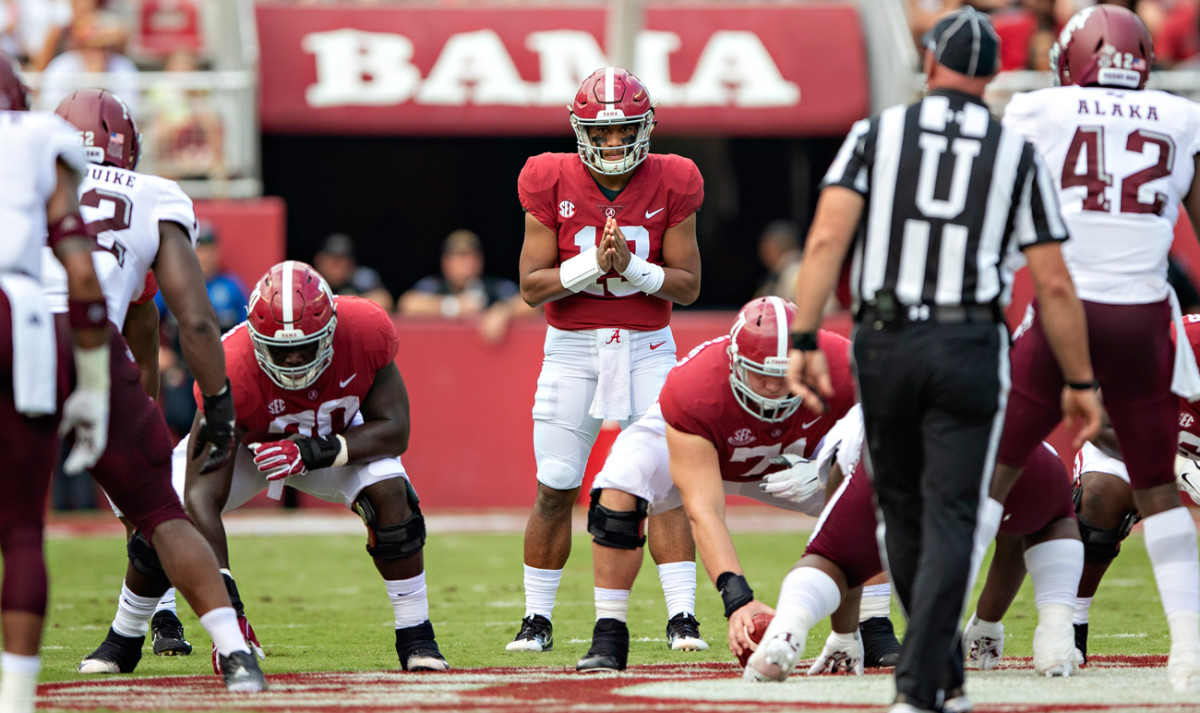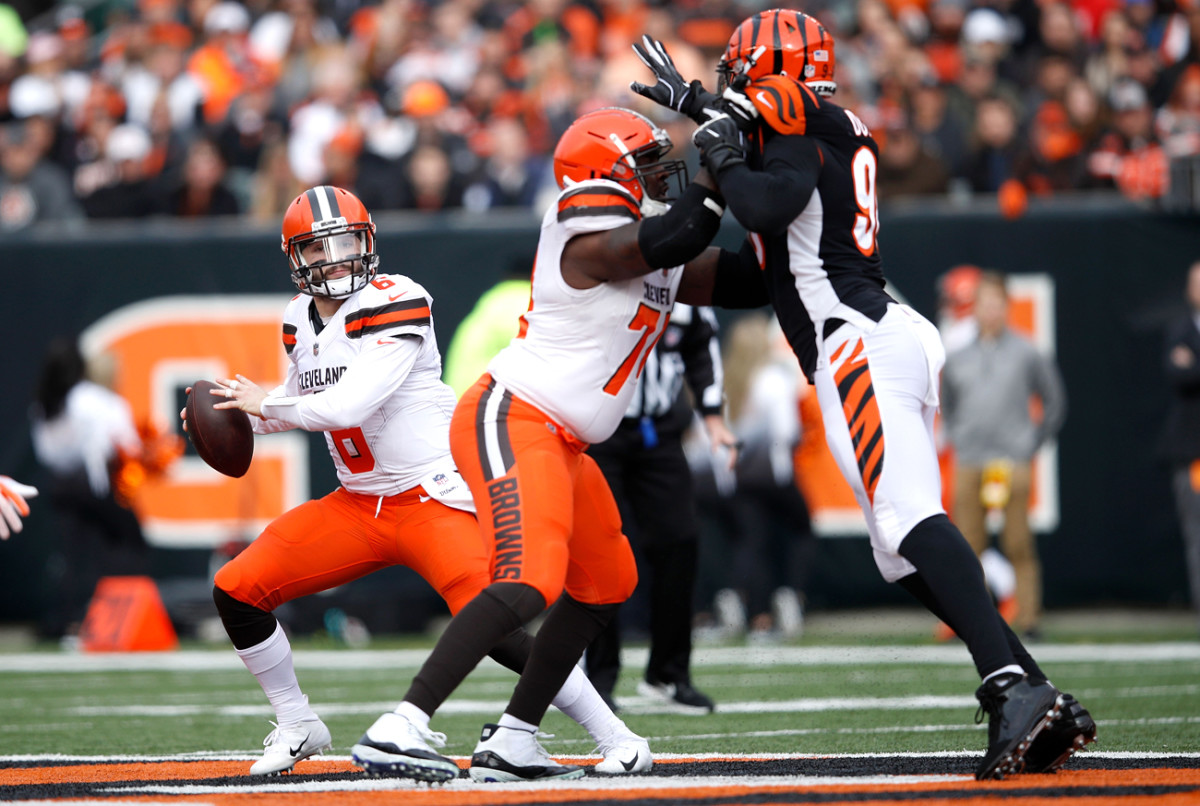Baker Mayfield, Tua Tagovailoa and the New Quarterback Mold

Tua Tagovailoa started just one full season of college football, and he’s more than a year away from being eligible for the NFL draft. But already, NFL fans are salivating at the possibility of his wearing their team’s uniform: TUA IN 2020.
The Alabama quarterback was as unstoppable this season as he was during his coming-out party in the second half of the Tide’s 26–23 national-title victory over Georgia last January. Despite a nagging knee injury, he lit up fields across the SEC, throwing deep posts with the same ease as RPO slants, while logging just two interceptions.
He also happens to be short—by NFL quarterback standards, that is. Tagovailoa is listed as 6'1" on Alabama’s website, but NFL scouts would be surprised if he measures more than 6 feet. And there’s a good chance that whichever team picks first in 2020 will say, So what?

That would not have happened a decade ago, but NFL franchise quarterbacks don’t look like they used to. Just ask Baker Mayfield, the 6' 5/8" QB drafted No. 1 by the Browns last April. “The old-school frame of mind is to find your 6'5" quarterback to stand in the pocket and throw the ball, but the game is changing,” Mayfield says. “Guys are a lot faster; [defenses are] able to get to the QB; you’ve gotta be able to move and extend plays and just make things happen.”
2019 DRAFT BIG BOARD:Justin Herbert moves into the top 10
For years, two main factors have been used to assess a quarterback’s pro potential: Does he stand tall in the pocket, and can he make the “NFL throw,” such as the deep out? But as offenses have changed across all levels of football, teams have adapted their QB criteria, both out of necessity and because the spread formations and concepts now being embraced in the league render height less critical.
The 6-foot Drew Brees and the 5'11" Russell Wilson, who have both won Super Bowls, have gone a long way toward changing perceptions. For both, size affected when they were drafted—Brees went in the second round in 2001, Wilson in the third in 2012. The fact that Mayfield was drafted first in 2018 indicates a shifting paradigm. The Browns deemed there was less risk in taking a small quarterback at No. 1 than in passing on him.
“The history of the NFL is simple: You get overdrafted if you fit the traditional look, and you get underdrafted if you don’t,” says Trent Dilfer, the 6' 4" NFL first-round quarterback who won a Super Bowl with the Ravens in 2000. “Baker was the league, finally, saying: You don’t have to look the part. He made it O.K. for talent evaluators to fight for guys like that.”
These guys include Tagovailoa, as well as Penn State’s Trace McSorley (6 feet), Washington State’s Gardner Minshew (6' 2") and Mayfield’s successor at Oklahoma, Kyler Murray (5' 11"—though Murray has said he’ll pursue a baseball career). Dilfer, head coach for the Elite 11 passing camp for the nation’s top high school quarterbacks, is in a perfect spot to see the future of the position. According to him, 90% of this year’s Power 5 starting quarterbacks, and 11 of the last 12 Heisman winners who played QB, have gone through the Elite 11 program. Dilfer sees the next wave of NFL QBs four or five years before they even get to the league.
2019 DRAFT:Team needs and targets for the bottom half of the league
While NFL evaluators have long coveted power and stature in quarterbacks, Dilfer asserts that what matters more is twitch and precision—in other words, moving quickly, thinking quickly and getting the ball to the right place. The NFL game used to be played in a tight scrum around the line of scrimmage, but the spread revolution has stretched the field with single backs, detached tight ends and receivers lining up in wide splits, opening up the throwing lanes. Says Jim Nagy, former longtime NFL scout and now the executive director of the Senior Bowl, “We’re shifting more to athleticism, and away from size. Instead of fighting it, the league is saying: At some point we’ve gotta give in a little.”
NFL teams use height, weight and speed measurements to try to quantify talent. The many coaches and GMs around the league who are Bill Parcells disciples cite his famous adage, “Make one exception, and the next thing you know, you have a team full of them.” But which players are the exceptions? Scouting manuals in the 1980s, for example, talk about 265- to 270-pound offensive linemen—30 to 40 pounds smaller than most blockers today.

Mike Giddings, who runs ProScout, Inc., a service used by several NFL teams, sets parameters for each position based not on all players in the league but rather on those currently performing well. Giddings uses a color-coded rating system—blue represents the best of the best; red, solid starters; purple, players you can win with; and so on. He groups the players at each position who are playing at a purple level or better, and then calculates the height, weight and speed parameters into which 90% of them fall. Based on these criteria, Mayfield, who is taller than both Brees and Wilson, wouldn’t have been considered a height outlier.
2019 DRAFT:Team needs and targets for the top half of the league
None of this is to say that teams aren’t looking for another 6' 5", 237-pound Carson Wentz. Justin Herbert, the 6' 6" Oregon QB, figures to be selected near the top of the 2019 draft if he comes out. But of course no one factor is determinative. Mayfield went No. 1 because he was exceptional in the areas that Dilfer described—his quick release, quick eyes, great feet and tremendous accuracy. Then there is his proven competitive spirit.
The same figures to be true for Tagovailoa. Nagy was working as a Southeast-area scout for the Seahawks when Alabama was recruiting Tagovailoa out of Hawaii, and the scout recalls members of their staff telling him, “He reminds us of your guy,” referring to Wilson.
“People still have their doubts,” Mayfield says. “But we’ve had guys like Drew Brees and Russell Wilson to help pave the way, to maybe keep an open mind. All we can do is allow those other guys to get a fair chance.”
Question or comment? Email us at talkback@themmqb.com.
